Sign In to Your Account
Subscribers have complete access to the archive.
Sign In Not a Subscriber?Join NowIf anything can save the world (and the music industry) from terminal cynicism, it's a near half-century of talent under the generous umbrella marked "folk." Think of the troubadour spirit of the Guthrie Clan, the transcendent bite of Joni Mitchel, and the triple hammer of Peter, Paul and Mary—they are among the 60s veterans still going strong, even as, the torch is grasped by the likes of Feist. Ray LaMontagne, and Devendra Banhart. ANNIE LEIBOVITZ photographs folk's finest, who sing to the best in human nature
November 2007 Annie Leibovitz Jessica DiehlIf anything can save the world (and the music industry) from terminal cynicism, it's a near half-century of talent under the generous umbrella marked "folk." Think of the troubadour spirit of the Guthrie Clan, the transcendent bite of Joni Mitchel, and the triple hammer of Peter, Paul and Mary—they are among the 60s veterans still going strong, even as, the torch is grasped by the likes of Feist. Ray LaMontagne, and Devendra Banhart. ANNIE LEIBOVITZ photographs folk's finest, who sing to the best in human nature
November 2007 Annie Leibovitz Jessica Diehl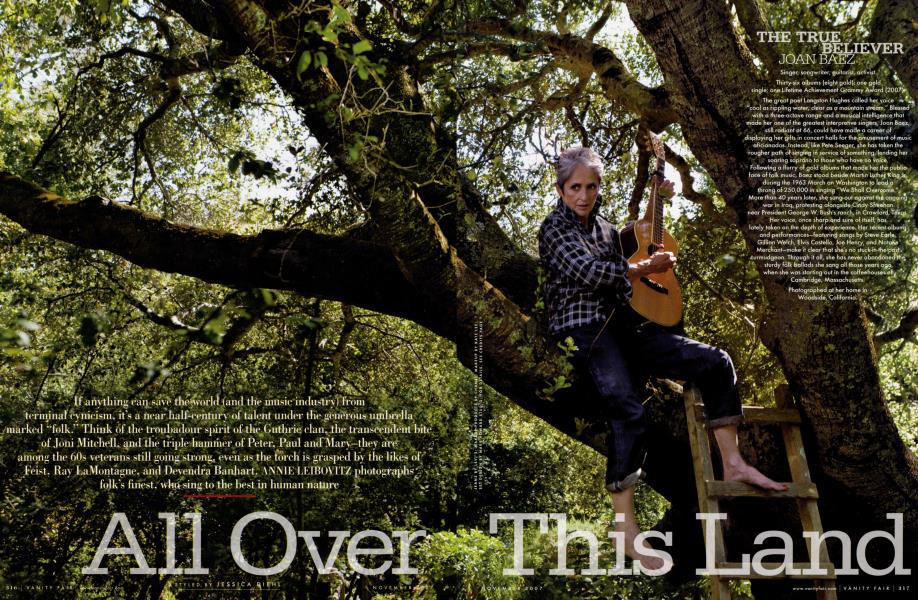
The great poet Langston Hughes called her voice "cool as rippling water, clear as a mountain stream." Blessed with a three-octave range and a musical intelligence that made her one of the greatest interpretive singers, Joan Baez, still radiant at 66, could have made a career of displaying her gifts in concert halls for the amusement of music aficionados. Instead, like Pete Seeger, she has taken the rougher path of singing in service of something, lending her soaring soprano to those who have no voice. Following a flurry of gold albums that made her the public face of folk music, Baez stood beside Martin Luther King Jr. during the 1963 March on Washington to lead a throng of 250,000 in singing "We Shall Overcome." More than 40 years later, she sang out against the ongoing war in Iraq, protesting alongside Cindy Sheehan near President George W. Bush's ranch, in Crawford, Texas. Her voice, once sharp and sure of itself, has lately taken on the depth of experience. Her recent album and performances—featuring songs by Steve Earle, Gillian Welch, Elvis Costello, Joe Henry, and Natalie Merchant—make it clear that she's no stuck-in-the-past curmudgeon. Through it all, she has never abandoned the sturdy folk ballads she sang all those years ago, when she was starting out in the coffeehouses of Cambridge, Massachusetts.
Photographed at her home in Woodside, California.
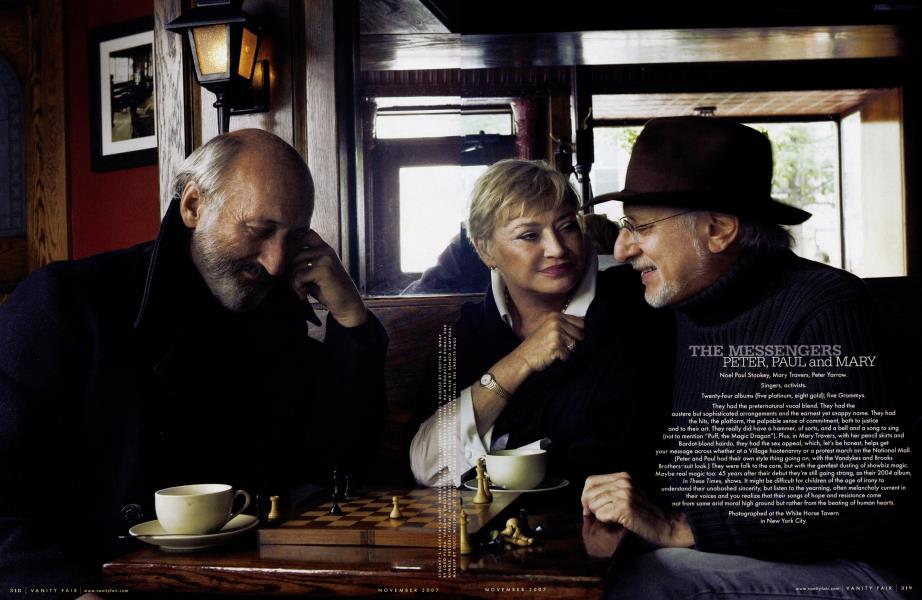
They had the preternatural vocal blend. They had the austere but sophisticated arrangements and the earnest yet snappy name. They had the hits, the platform, the palpable sense of commitment, both to justice and to their art. They really did have a hammer, of sorts, and a bell and a song to sing (not to mention "Puff, the Magic Dragon"). Plus, in Mary Travers, with her pencil skirts and Bardot-blond hairdo, they had the sex appeal, which, let's be honest, helps get your message across whether at a Village hootenanny or a protest march on the National Mall. (Peter and Paul had their own style thing going on, with the Vandykes and Brooks Brothers-suit look.) They were folk to the core, but with the gentlest dusting of showbiz magic. Maybe real magic too: 45 years after their debut they're still going strong, as their 2004 album, In These Times, shows. It might be difficult for children of the age of irony to understand their unabashed sincerity, but listen to the yearning, often melancholy current in their voices and you realize that their songs of hope and resistance come not from some arid moral high ground but rather from the beating of human hearts.
Photographed at the White Horse Tavern in New York City.
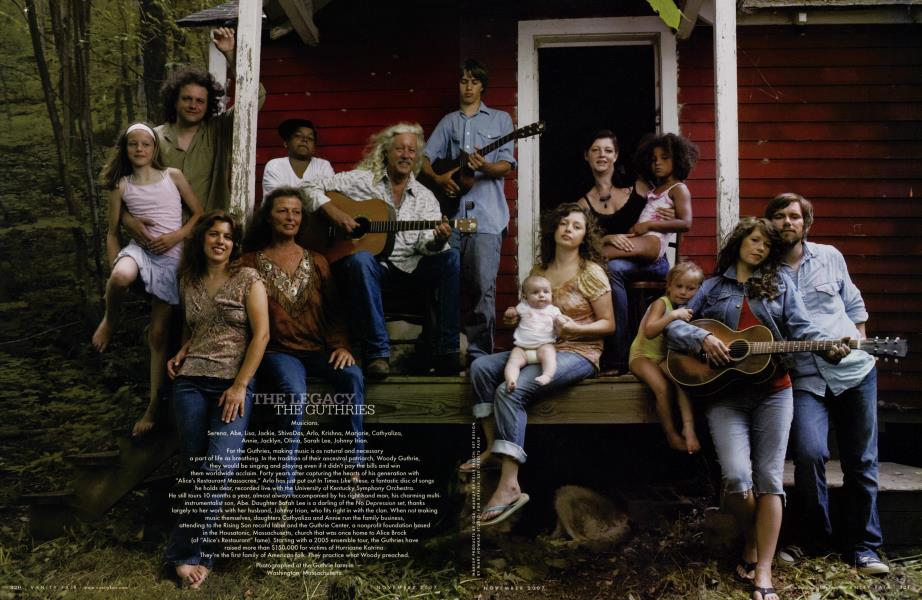
For the Guthries, making music is as natural and necessary a part of life as breathing. In the tradition of their ancestral patriarch, Woody Guthrie, they would be singing and playing even if it didn't pay the bills and win them worldwide acclaim. Forty years after capturing the hearts of his generation with "Alice's Restaurant Massacree," Arlo has just put out In Times Like These, a fantastic disc of songs he holds dear, recorded live with the University of Kentucky Symphony Orchestra. He still tours 10 months a year, almost always accompanied by his right-hand man, his charming multi-instrumentalist son, Abe. Daughter Sarah Lee is a darling of the No Depression set, thanks largely to her work with her husband, Johnny Irion, who fits right in with the clan. When not making music themselves, daughters Cathyaliza and Annie run the family business, attending to the Rising Son record label and the Guthrie Center, a nonprofit foundation based in the Housatonic, Massachusetts, church that was once home to Alice Brock (of "Alice's Restaurant" fame). Starting with a 2005 ensemble tour, the Guthries have raised more than $150,000 for victims of Hurricane Katrina.They're the first family of American folk. They practice what Woody preached.
Photographed at the Guthrie farm in Washington, Massachusetts.
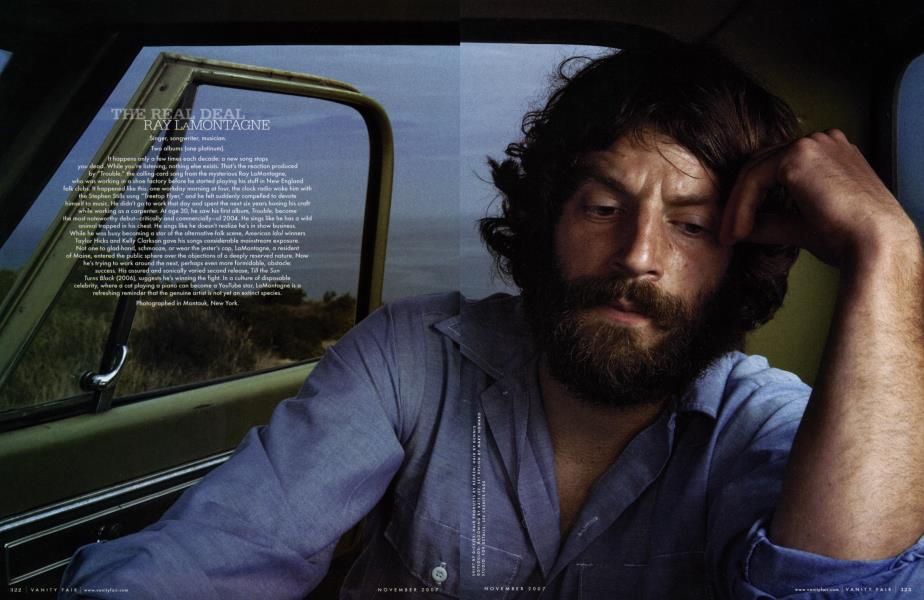
It happens only a few times each decade: a new song stops you dead While you're listening, nothing else exists. That's the reaction produced by "Trouble," the calling-card song from the mysterious Ray LaMontagne, who was working in a shoe factory before he started playing his stuff in New England folk clubs It happened like this: one workday morning at four, the clock radio woke him with the Stephen Stills song "Treetop Flyer," and he felt suddenly compelled to devote himself to music. He didn't go to work that day and spent the next six years honing his craft while working as a carpenter. At age 30, he saw his first album, Trouble, become the most noteworthy debut—critically and commercially—of 2004. He sings like he has a wild animal trapped in his chest. He sings like he doesn't realize he's in show business. While he was busy becoming a star of the alternative-folk scene, American Idol winners Taylor Hicks and Kelly Clarkson gave his songs considerable mainstream exposure. Not one to glad-hand, schmooze, or wear the jester's cap, LaMontagne, a resident of Maine, entered the public sphere over the objections of a deeply reserved nature. Now he's trying to work around the next, perhaps even more formidable, obstacle: success. His assured and sonically varied second release, Till the Sun Turns Black (2006), suggests he's winning the fight. In a culture of disposable celebrity, where a cat playing a piano can become a YouTube star, LaMontagne is a refreshing reminder that the genuine artist is not yet an extinct species.
Photographed in Montauk, New York.
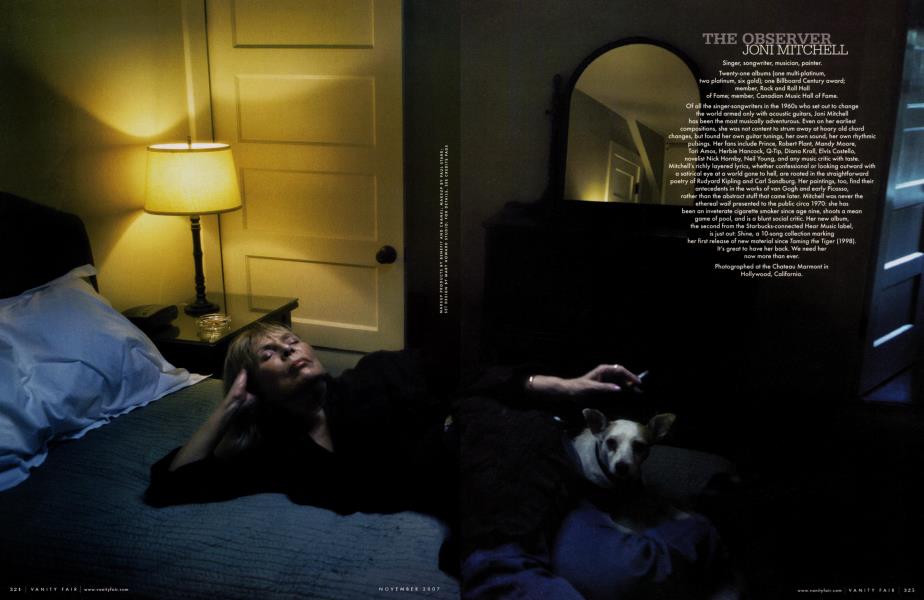
Of all the singer-songwriters in the 1960s who set out to change the world armed only with acoustic guitars, Joni Mitchell has been the most musically adventurous. Even on her earliest compositions, she was not content to strum away at hoary old chord changes, but found her own guitar tunings, her own sound, her own rhythmic pulsings. Her fans include Prince, Robert Plant, Mandy Moore, Tori Amos, Herbie Hancock, Q-Tip, Diana Krall, Elvis Costello, novelist Nick Hornby, Neil Young, and any music critic with taste. Mitchell's richly layered lyrics, whether confessional or looking outward with a satirical eye at a world gone to hell, are rooted in the straightforward poetry of Rudyard Kipling and Carl Sandburg. Her paintings, too, find their antecedents in the works of van Gogh and early Picasso, rather than the abstract stuff that came later. Mitchell was never the ethereal waif presented to the public circa 1970: she has been an inveterate cigarette smoker since age nine, shoots a mean game of pool, and is a blunt social critic. Her new album, the second from the Starbucks-connected Hear Music label, is just out: Shine, a 10-song collection marking her first release of new material since Taming the Tiger (1998). It's great to have her back. We need her now more than ever.
Photographed at the Chateau Marmont in Hollywood, California.
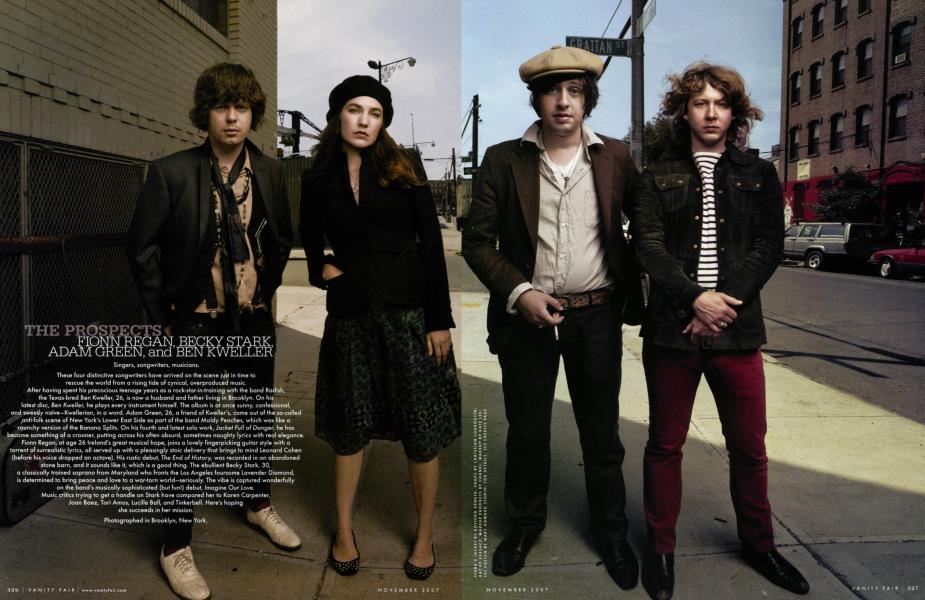
These four distinctive songwriters have arrived on the scene just in time to rescue the world from a rising tide of cynical, overproduced music. After having spent his precocious teenage years as a rock-star-in-training with the band Radish, the Texas-bred Ben Kweller, 26, is now a husband and father living in Brooklyn. On his latest disc, Ben Kweller, he plays every instrument himself. The album is at once sunny, confessional, and sweetly naïve—Kwellerian, in a word. Adam Green, 26, a friend of Kweller's, came out of the so-called anti-folk scene of New York's Lower East Side as part of the band Moldy Peaches, which was like a raunchy version of the Banana Splits. On his fourth and latest solo work, Jacket Full of Danger, he has become something of a crooner, putting across his often absurd, sometimes naughty lyrics with real elegance. Fionn Regan, at age 26 Ireland's great musical hope, joins a lovely fingerpicking guitar style with a torrent of surrealistic lyrics, all served up with a pleasingly stoic delivery that brings to mind Leonard Cohen (before his voice dropped an octave). His rustic debut, The End of History, was recorded in an abandoned stone barn, and it sounds like it, which is a good thing. The ebullient Becky Stark, 30, a classically trained soprano from Maryland who fronts the Los Angeles foursome Lavender Diamond, is determined to bring peace and love to a war-torn world—seriously. The vibe is captured wonderfully on the band's musically sophisticated (but fun!) debut, Imagine Our Love. Music critics trying to get a handle on Stark have compared her to Karen Carpenter, Joan Baez, Tori Amos, Lucille Ball, and Tinkerbell. Here's hoping she succeeds in her mission.
Photographed in Brooklyn, New York.
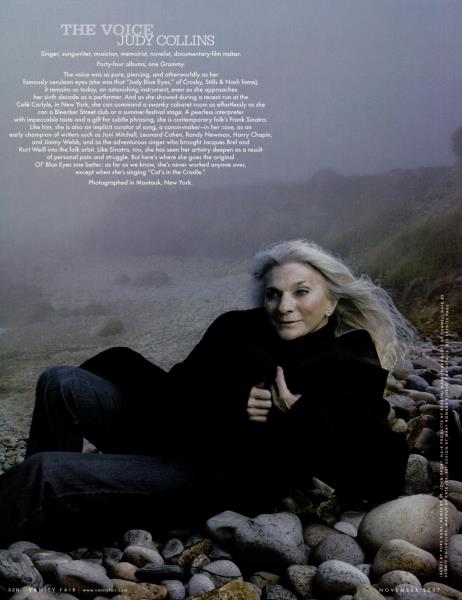
The voice was as pure, piercing, and otherworldly as her famously cerulean eyes (she was that "Judy Blue Eyes," of Crosby, Stills & Nash fame); it remains so today, an astonishing instrument, even as she approaches her sixth decade as a performer. And as she showed during a recent run at the Café Carlyle, in New York, she can command a swanky cabaret room as effortlessly as she can a Bleecker Street club or a summer-festival stage. A peerless interpreter with impeccable taste and a gift for subtle phrasing, she is contemporary folk's Frank Sinatra. Like him, she is also an implicit curator of song, a canon-maker—in her case, as an early champion of writers such as Joni Mitchell, Leonard Cohen, Randy Newman, Harry Chapin, and Jimmy Webb, and as the adventurous singer who brought Jacques Brel and Kurt Weill into the folk orbit. Like Sinatra, too, she has seen her artistry deepen as a result of personal pain and struggle. But here's where she goes the original Ol' Blue Eyes one better: as far as we know, she's never worked anyone over, except when she's singing "Cat's in the Cradle."
Photographed in Montauk, New York.
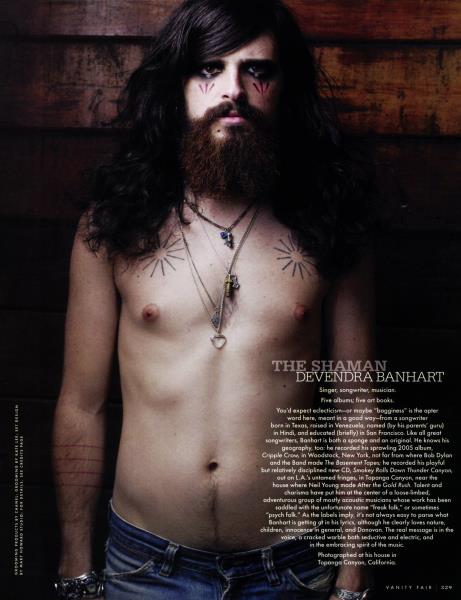
You'd expect eclecticism-or maybe "bagginess" is the apter word here, meant in a good way-from a songwriter born in Texas, raised in Venezuela, named (by his parents' guru) in Hindi, and educated (briefly) in San Francisco. Like all great songwriters, Banhart is both a sponge and an original. He knows his geography, too: he recorded his sprawling 2005 album, Cripple Crow, in Woodstock, New York, not far from where Bob Dylan and the Band made The Basement Tapes; he recorded his playful but relatively disciplined new CD, Smokey Rolls Down Thunder Canyon, out on L.A's untamed fringes, in Topanga Canyon, near the house where Neil Young made After the Gold Rush. Talent and charisma have put him at the center of a loose-limbed, adventurous group of mostly acoustic musicians whose work has been saddled with the unfortunate name "freak folk," or sometimes "psych folk." As the labels imply, it's not always easy to parse what Banhart is getting at in his lyrics, although he clearly loves nature, children, innocence in general, and Donovan. The real message is in the voice, a cracked warble both seductive and electric, and in the embracing spirit of the music.
Photographed at his house in Topanga Canyon, California.

It's hard to get a handle on Feist, which is a good thing for her and a less good thing for critics and journalists. Since the release of her breakthrough solo album, Let It Die, in 2004, her music has been called indie-folk, lounge-folk, folk-rock, folk-pop, folk-electronica, and plenty of other hybrid labels that ditch the word "folk" altogether. (Writers can't even agree on which bang-wearing French gamine from the 1960s this daughter of Calgary more closely resembles—Jane Birkin? Françoise Hardy?) Her songs come across as both casual and considered, while her stage persona is similarly etched in shades of gray: she can sing with a shrug and a plea at the same time. (That gamine thing again.) She and her countrywoman Joni Mitchell share a fascination with musical texture and a lyrical bent toward affairs of the heart; her voice has a touch of the young Joni's ethereality, too, but brought back to earth with an eccentric burr—clean mountain air wreathed with a little smoke. But enough hairsplitting. Her recent album, The Reminder, is one of the year's finest, pure and simple.
Photographed in New York City.
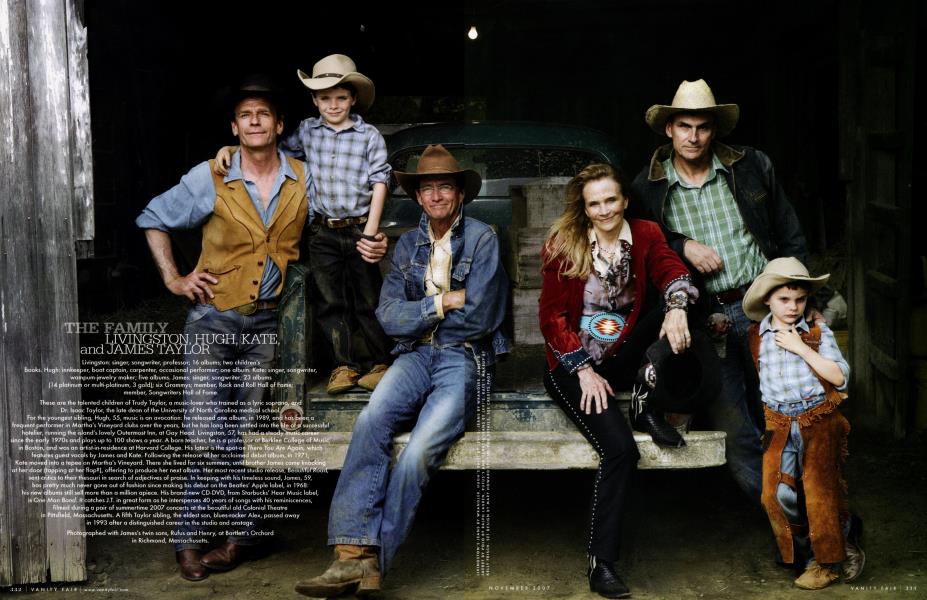
These are the talented children of Trudy Taylor, a music-lover who trained Dr. Isaac Taylor, the late dean of the University of North Carolina For the youngest sibling, Hugh, 55, music is an avocation: he released one album, in 1989, and has been a frequent performer in Martha's Vineyard clubs over the years, but he has long been settled into the life of a successful hotelier, running the island's lovely Outermost Inn, at Gay Head. Livingston, 57, has had a steady music career since the early 1970s and plays up to 100 shows a year. A born teacher, he is a professor at Berklee College of Music, in Boston, and was an artist-in-residence at Harvard College. His latest is the spot-on There You Are Again, which features guest vocals by James and Kate. Following the release of her acclaimed debut album, in 1971, Kate moved into a tepee on Martha's Vineyard. There she lived for six summers, until brother James came knocking at her door (tapping at her flap?), offering to produce her next album. Her most recent studio release, Beautiful Road, sent critics to their thesauri in search of adjectives of praise. In keeping with his timeless sound, James, 59, has pretty much never gone out of fashion since making his debut on the Beatles' Apple label, in 1968: his new albums still sell more than a million apiece. His brand-new CD-DVD, from Starbucks' Hear Music label, is One Man Band. It catches J.T. in great form as he intersperses 40 years of songs with his reminiscences, filmed during a pair of summertime 2007 concerts at the beautiful old Colonial Theatre in Pittsfield, Massachusetts. A fifth Taylor sibling, the eldest son, blues-rocker Alex, passed away in 1993 after a distinguished career in the studio and onstage.
Photographed with James's twin sons, Rufus and Henry, at Bartlett's Orchard in Richmond, Massachusetts.
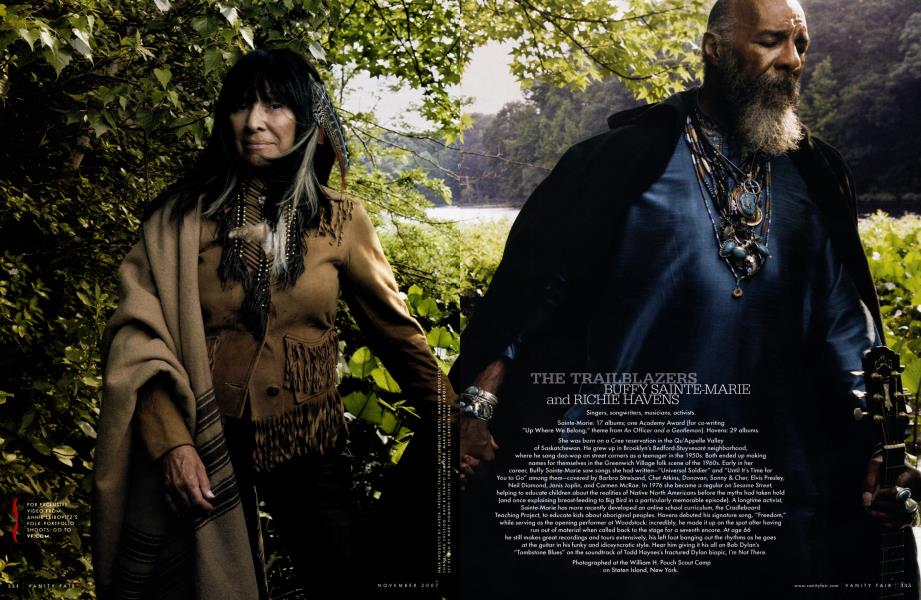
She was born on a Cree reservation in the Qu'Appelle Valley of Saskatchewan. He grew up in Brooklyn's Bedford-Stuyvesant neighborhood, where he sang doo-wop on street corners as a teenager in the 1950s. Both ended up making names for themselves in the Greenwich Village folk scene of the 1960s. Early in her career, Buffy Sainte-Marie saw songs she had written—" Universal Soldier" and "Until It's Time for You to Go" among them—covered by Barbra Streisand, Chef Atkins, Donovan, Sonny & Cher, Elvis Presley, Neil Diamond, Janis Joplin, and Carmen McRae. In 1976 she became a regular on Sesame Street, helping to educate children about the realities of Native North Americans before the myths had taken hold (and once explaining breast-feeding to Big Bird in a particularly memorable episode). A longtime activist, Sainte-Marie has more recently developed an online school curriculum, the Cradleboard Teaching Project, to educate kids about aboriginal peoples. Havens debuted his signature song, "Freedom," while serving as the opening performer at Woodstock: incredibly, he made it up on the spot after having run out of material when called back to the stage for a seventh encore. At age 66 he still makes great recordings and tours extensively, his left foot banging out the rhythms as he goes at the guitar in his funky and idiosyncratic style. Hear him giving it his all on Bob Dylan's "Tombstone Blues" on the soundtrack of Todd Haynes's fractured Dylan biopic, I'm Not There.
Photographed at the William H. Pouch Scout Camp on Staten Island, New York.
 View Full Issue
View Full Issue


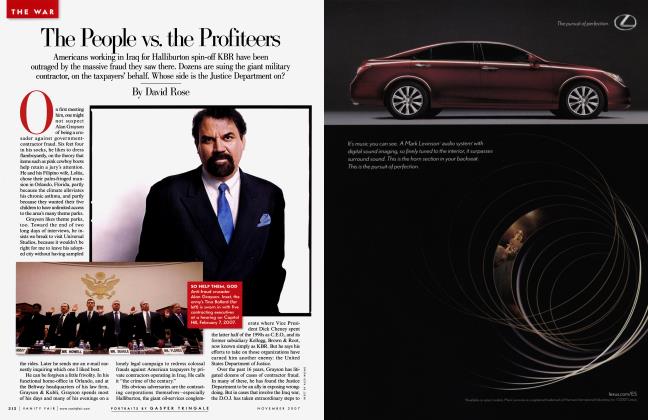

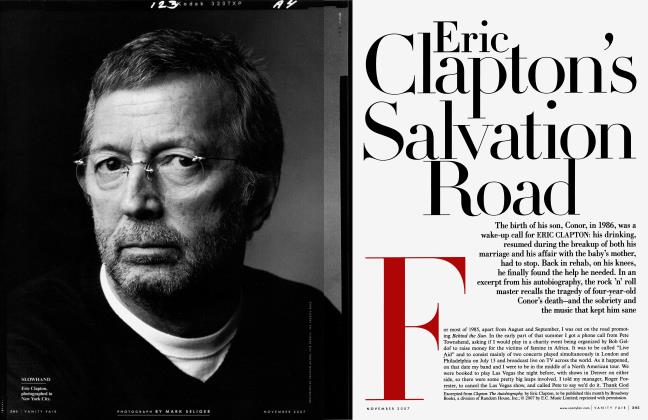



















Subscribers have complete access to the archive.
Sign In Not a Subscriber?Join Now